If you’ve turned on the TV, opened a newspaper or spent any time on the internet in the last year, you’ll know that a lot of people have been talking about ADHD.
Documentary films commissioned by Channel 4 have followed celebrities on the process of finding out whether they have ADHD, google searches for the term have more than quadrupled in the UK in the last five years and creators on TikTok and Instagram have posted reams of content on what it’s like to have attention deficit hyperactivity disorder.
But what does it mean to have ADHD and what has driven this seemingly sudden interest in the condition?
According to a statement on ADDitude magazine’s website: ‘Neuroscience, brain imaging, and clinical research tell us a few important things: ADHD is not a behaviour disorder. ADHD is not a mental illness. ADHD is not a specific learning disability. ADHD is, instead, a developmental impairment of the brain’s self-management system. Both adults and children can be diagnosed with ADHD.’
While the condition was traditionally thought to only affect children and teenagers, overwhelming evidence in the last few decades has shown that ADHD is a lifelong condition affecting a great number of adults. In fact, the number of people who are late diagnosed in adulthood has been rising drastically in recent years.
ADHD symptoms can vary from person to person, depending on a range of factors, including gender and ADHD type but there are a few common symptoms which most people with ADHD experience.
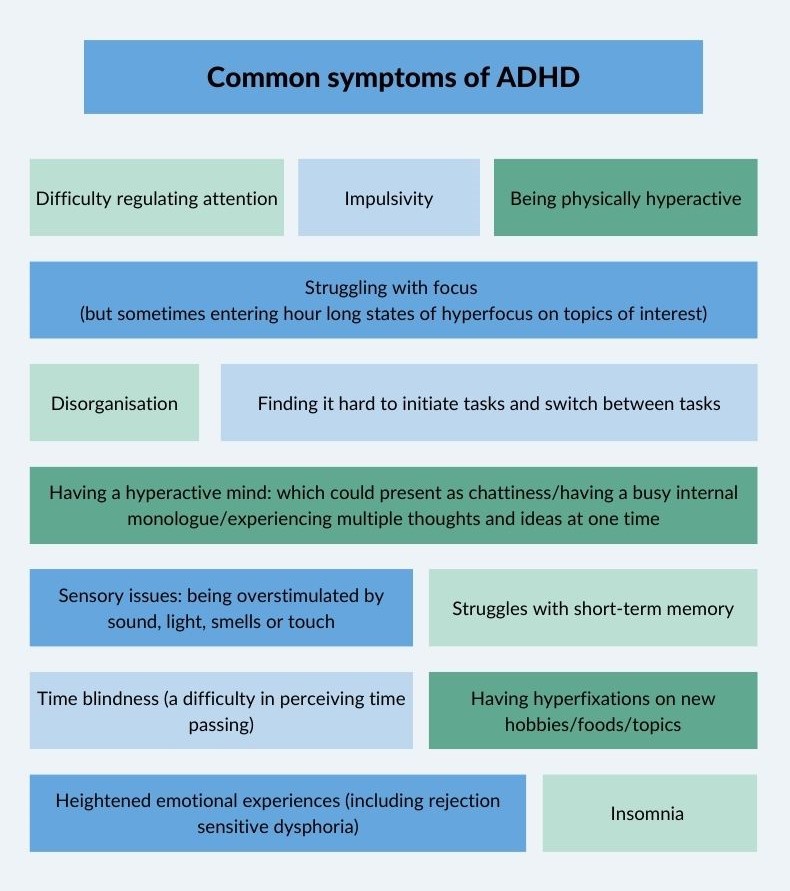
To receive an ADHD diagnosis as an adult, a person would need to exhibit a majority of the symptoms that they were being tested for, with proof that those symptoms were present in childhood and that they’re having a moderate impact on their daily life.
There are three official ADHD types that can be diagnosed in the UK: hyperactive, inattentive and combined, with symptoms broadly falling into either the hyperactive or inattentive category.
According to data from NICE in August 2023:
- The combined subtype is the most commonly diagnosed and accounts for 50% to 75% of cases
- The inattentive subtype accounts for 20% to 30% of cases
- The hyperactive-impulsive subtype is the least common, accounting for around 15% of cases
Rates of ADHD diagnoses are far higher in male patients. Male patients are also more likely to be diagnosed with hyperactive ADHD while women are more commonly diagnosed with inattentive type. It’s thought that this is due to gendered differences in the presentation of symptoms. It’s believed that women/girls are more likely to mask and hide their symptoms, with boys and men more likely to demonstrate traits of hyperactivity in more noticeable ways. Many boys of school age with ADHD may have been diagnosed as a result of “disruptive” behaviour in the classroom drawing attention to their symptoms.
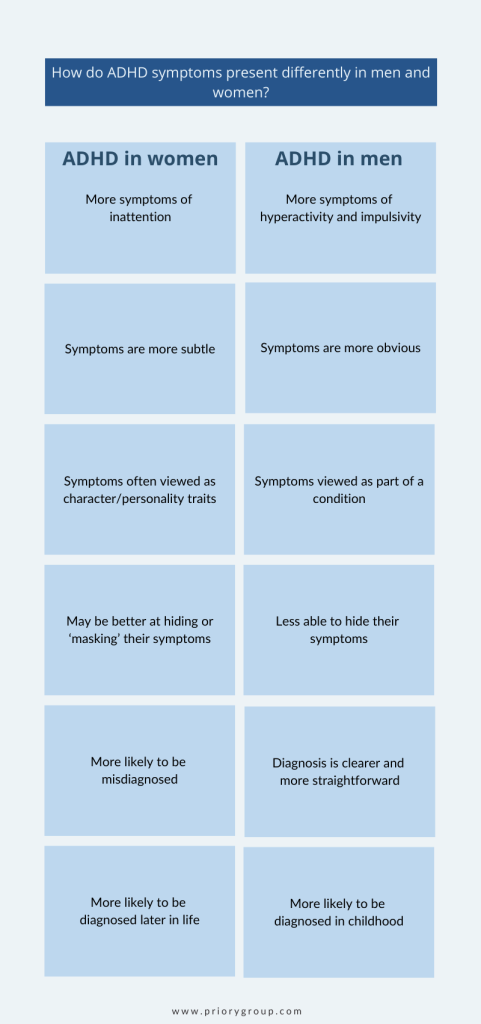
DIFFERENT PRESENTATIONS OF ADHD IN MEN AND WOMEN: As stated by The Priory Group on its website.
The struggle to get diagnosed
Why have women been consistently underdiagnosed and why has there only recently been such a rise in the number of women being diagnosed with ADHD?
From 2000 to 2018 the rate of new ADHD diagnoses in girls under the age of eighteen quadrupled, while the rate of new ADHD diagnoses in women aged over 18 years increased 15-fold.
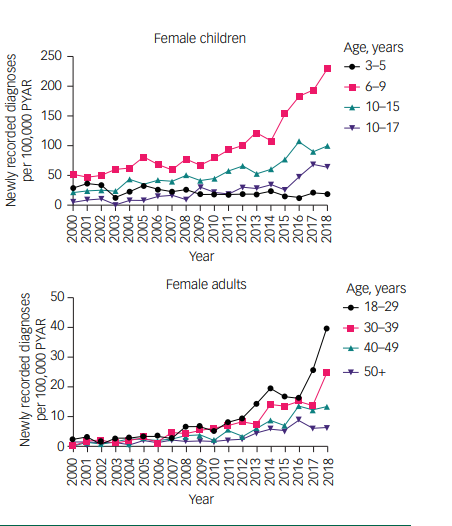
Source: BJPsych Open – Attention-deficit hyperactivity disorder diagnoses and prescriptions in UK primary care, 2000–2018: population-based cohort study
Molly Daniel, a 20-year-old student in Nottingham, sought a diagnosis of ADHD after she found herself struggling with organisation and focus when she started her A Levels.
“Suddenly there was very little structure,” she said. “You had a lot of free time and you suddenly had to self-discipline a lot, which I’d never had to do.. I had loads of mental health problems. I saw the school counsellor for possible depression.”
What seems to be a common thread in late diagnosed ADHD adults (and in particular women) is the intensification of struggles and inability to cope once the routines and timetables of school fall away. The pressures of adulthood can bring symptoms of ADHD into sharper focus as more independent task initiation and structure is expected with age.
With little knowledge on what could be causing these issues, Molly took to the internet and started googling symptoms of what she had been struggling with.
“Eventually ADHD came up,” she said. “So I just kind of read the whole list, cried violently, went back to sleep, closed the tab, ignored it for a week, looked at it again, sort of thought about it and eventually took it to my parents and started from there.”
After speaking to her parents about what she had learned and how she was struggling, they began to research together. Looking through the symptoms online, Molly’s mum agreed that she could see a lot of the characteristics of ADHD in her daughter. They decided to pursue a diagnosis.
The choice to pursue an official diagnosis can be a complicated one. For some people struggling with symptoms of ADHD, the discovery of the condition along with resources on how to manage, with strategies and coping mechanisms provides enough resolve for them to navigate life without a formal diagnosis.
For others, the choice to pursue an assessment is critical, allowing them to gain clarification on why they have been struggling, and opening the doors for them to access support for the condition that is registered as a disability under the 2010 Equality Act.
Having a formal diagnosis of ADHD isn’t just helpful for accessing treatment like medication or coaching, it also allows people to access the reasonable adjustments they’re entitled to in education and the workplace.
Despite understanding the theory that girls are underdiagnosed due to being less more inattentive and less hyperactive, Molly felt that this didn’t really apply to her.
Molly explained that there were other people in her family with the condition. She said: “My cousin, who’s a boy, has been diagnosed since he was a child. But even with a family history, it just didn’t enter anyone’s head that I might possibly have it. And it was annoying because I think if I’d known sooner, a lot of things would have been easier for me.”
Receiving an ADHD diagnosis as an adult can bring up a lot of conflicting emotions. Having undiagnosed ADHD as a child and being told off for behaviour that you can’t control or understand can have a lasting impact on a person’s self-esteem. The impact of living with ADHD goes beyond struggling to focus or initiate tasks, it can take a huge mental toll on those who navigate life with it.
For Molly, a diagnosis was crucial to her accessing the support that she needed ahead of her first year of university.
Similarly to Molly, Ashleigh Brown, 23, first thought that she might have ADHD after repeatedly struggling to focus in class.
Ashleigh went to her GP and asked to be assessed for ADHD a few years after leaving school. After beginning full time employment she found that she was still struggling and wanted to seek answers and support.
Rising waiting times and the struggle to get an assessment
There are significant problems with the referral and assessment process for ADHD in the UK. In October last year, ITV News reported that the average wait time for a referral for ADHD was three years. As referrals for assessments are accessed by going to your GP and then being passed on to the ADHD services that are available in your local area, it’s been described as a ‘postcode lottery’ because of the huge differences in wait times and quality of resources available across the country.
The charity ADHD UK recently published a report into NHS ADHD assessment waiting lists after making freedom of information requests to every integrated health board in the country. The most shocking data found that at the time of the request the adult waiting the longest had been waiting 443 weeks for an ADHD assessment – (8.5 years). The waiting lists ranged from 12 weeks in Dorset to ten years in Herefordshire and Worcestershire. What is especially concerning though, are all of the waiting lists that there is no data for. Of all of the integrated care boards contacted, only 21% of the ICB’s could supply data to the charity, as most of them simply do not know how long people are waiting.
ADHD UK estimates that there are 131,000 people waiting for an assessment with 90,000 of those being adults. The charity points out that 131,000 people make up 5% of the estimated 2.6 million people in the UK with ADHD, making it a significant resourcing problem rather than a short-term issue from a spike in people reaching out for help.
The charity also found that a number of NHS organisations have started to use various tools to screen out individual ADHD referrals, eliminating them from waiting lists before they even get a chance to be assessed. These patients have already gone to their GP and discussed ADHD, requested to be assessed, completed forms that ask questions on their symptoms, returned those to their GP, after which the GP has decided to formally refer them to be assessed. Under the NHS, patients also cannot request second opinions, so those who are screened out aren’t able to pursue an ADHD diagnosis unless they are able to pay for one privately.
ADHD UK’s data shows that women are 16% more likely to be screened out than men, despite the fact that NICE guidelines state that women and girls are underdiagnosed.
For organisations that engage in screening, 32% of adults will be screened out, with the rates being 33% for women and 29% for men. The highest screening rates in the country have been found in Sheffield Health and Social Care NHS Foundation Trust. In the year of 2022-23 the trust screened out 97% of the adults referred to them, removing 1060 people from the waiting list and assessing only 33 adults.
Accessing assessment services and reaching out to GP surgeries is already quite a feat for those struggling with symptoms of ADHD considering some of the hallmark criteria for the condition involves: having difficulty with task initiation, short-term memory issues and problems with organisation. The discovery that individuals who have already been screened by their GP’s and referred on for assessment are being removed from waiting lists is something that ADHD UK has found very worrying.
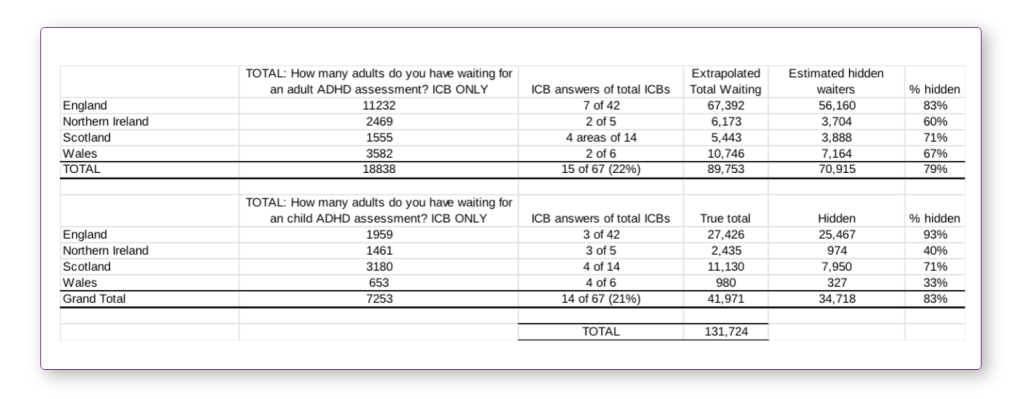
Source: ADHD UK
“Right to choose” and the growth of online assessment providers
While the waiting times for assessments through the NHS have been rising over the last few years, a number of psychiatry service providers have popped up online.
As an NHS patient you have a legal right to choose the provider of your care once referred to a specialist by your GP.
Online psychiatry care providers such as Psychiatry UK, ADHD 360 and Clinical Partners assess people remotely. Waiting times have been significantly shorter than on the NHS, and the numbers of patients choosing this route has been steadily increasing. So much so, that a few online providers had to pause accepting new referrals last year, due to the volume of new patients that were accessing their services.
Ashleigh pursued a diagnosis through Psychiatry UK and was assessed in a zoom call with a psychiatrist who diagnosed her with combined-type ADHD in the summer of last year.
Discovering that she had ADHD was a validating experience for Ashleigh. She explained the light that it shed on her upbringing and struggles with her mental health and time at school.
Molly also described feeling relieved after receiving her diagnosis. She shared the self-acceptance that learning this about herself brought and how she was able to work with her brain rather than in spite of it after being diagnosed.
The rise in the rates of women seeking ADHD assessments and diagnoses is a sign that public education and awareness of the condition is growing.
Diagnosis has, in so many cases, had a hugely positive impact on women with ADHD and the way that they are able to navigate their lives after gaining a better understanding of themselves. Many women with ADHD have found education and community on social media sites, which have proved important as waiting lists rise and those with ADHD struggle to access the resources they need.
As more data is compiled over the next few years, and public education of the condition grows, many hope that NHS assessment and diagnostic services in the UK will be improved to be fit for purpose. Those advocating for women with ADHD ask that adequate funding and resources are made available to support the more than 400% increase in adults that have come forward to seek a diagnosis for ADHD since 2020.
In October last year, a Department of Health and Social Care spokesperson told ITV News that the NHS is aware of the barriers that ADHD patients are facing and that they are working on improving ADHD services.
“We know how vital it is to have timely diagnoses for ADHD,” the spokesperson said.
“We are committed to reducing diagnosis delays and improving access to support.”
For support or further information on ADHD and to find out how to access help, you can reach out to the charity ADHD UK by heading to its website.
Featured image courtesy of Felicity Lynn via Unsplashed.com.




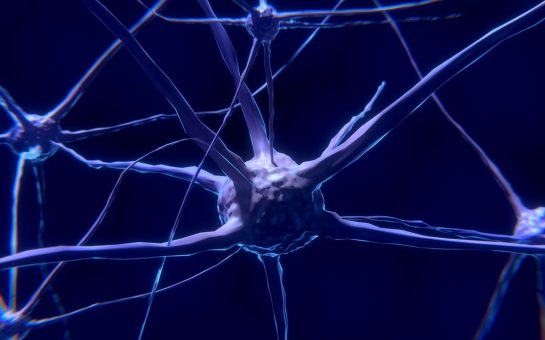
Join the discussion